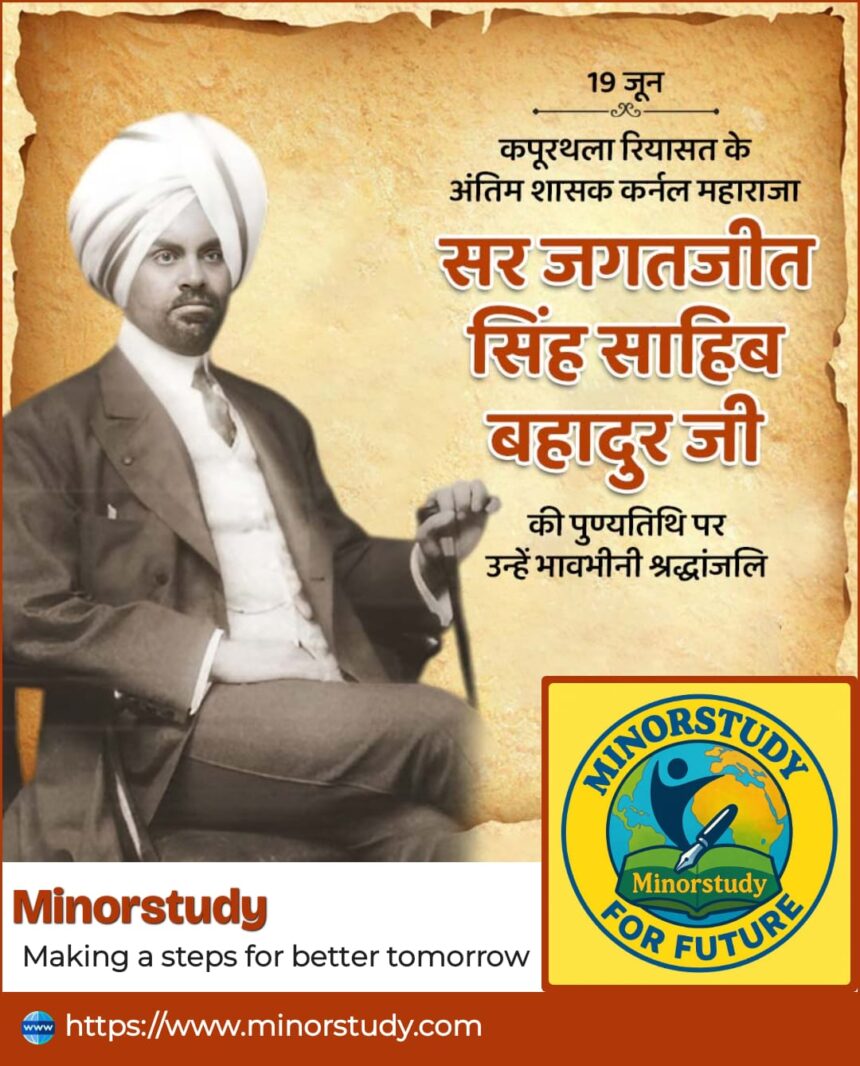7 Powerful Reasons Why Sir Jagatjit Singh Sahib Bahadur’s Royal Legacy Still Matters in Modern India
Sir Jagatjit Singh Sahib Bahadur Ji was not just a ruler—he was a visionary, a global diplomat, a progressive thinker, and one of the most charismatic monarchs of his time. His legacy continues to shine through the heritage of Kapurthala and the footprints he left on India’s cultural, political, and diplomatic history. This article is a tribute to his enduring relevance, diving deep into his history, timeline, facts, impact, and significance, along with wishes and lessons for modern life.
🏰 Who Was Sir Jagatjit Singh Sahib Bahadur Ji?
Sir Jagatjit Singh Sahib Bahadur (1872–1949) was the last ruling Maharaja of Kapurthala, a princely state in Punjab under the British Raj. Known for his deep appreciation of French art, architecture, and lifestyle, he was often called “India’s most European Maharaja.” A man of exquisite taste and international stature, he played significant roles not just in India but on diplomatic stages abroad.
📜 Detailed History of Sir Jagatjit Singh Sahib Bahadur Ji
-
Born: 24 November 1872 in Kapurthala
-
Succeeded to the Throne: At the young age of 20, in 1890
-
Died: 19 June 1949
Jagatjit Singh inherited a small yet culturally rich princely state and transformed it into a symbol of Indo-European grandeur. From commissioning the Jagdish Palace, inspired by the French Palace of Versailles, to encouraging secularism, art, and science, his contributions were vast.
He was knighted by the British and conferred titles such as:
-
GCSI (Knight Grand Commander of the Order of the Star of India)
-
GCIE (Knight Grand Commander of the Order of the Indian Empire)
📅 Timeline: Key Milestones in Sir Jagatjit Singh’s Life
| Year | Event |
|---|---|
| 1872 | Born in Kapurthala |
| 1877 | Became heir apparent |
| 1890 | Became Maharaja of Kapurthala |
| 1897 | Received British titles and represented India at Queen Victoria’s Diamond Jubilee |
| 1905–1930s | Built Jagatjit Palace and expanded Kapurthala as a modern city |
| 1920s | Member of the League of Nations, first Indian princely ruler to do so |
| 1947 | Signed Instrument of Accession to the Indian Union |
| 1949 | Passed away at the age of 76 |
📚 Interesting and Lesser-Known Facts
-
Polyglot Monarch – Fluent in French, Persian, Urdu, and English.
-
First Indian Prince at League of Nations – A groundbreaking achievement in international diplomacy.
-
Jagdish Palace – His palace is considered one of the finest examples of Indo-European architecture.
-
Cosmopolitan Visionary – Sent Kapurthala students abroad for higher education.
-
Progressive Ruler – Promoted women’s education and modern infrastructure in his kingdom.
❓ FAQs About Sir Jagatjit Singh Sahib Bahadur Ji
Q1: What made Sir Jagatjit Singh a unique Indian ruler?
A: His European lifestyle, diplomatic engagements, and modernist outlook set him apart from his contemporaries.
Q2: Did he play a role in Indian Independence?
A: While he remained loyal to the British during his reign, he gracefully merged Kapurthala into the Indian Union post-1947, showcasing maturity and foresight.
Q3: Where is his legacy most visible today?
A: In Kapurthala’s Jagdish Palace, Elysee Palace-inspired buildings, and the culture of secularism and education he nurtured.
Q4: Was he related to any global leaders?
A: Not directly, but he was a frequent guest and participant in diplomatic events across Europe.
Q5: Why is he important in Indian royal history?
A: His reign symbolizes fusion of tradition and modernity—rare in the colonial era.
🌟 Significance in Modern Society
Sir Jagatjit Singh Sahib Bahadur’s life reflects themes that are still relevant today:
-
Global Outlook: His open-minded embrace of international culture is a lesson in cultural diplomacy.
-
Respect for Heritage: He modernized Kapurthala without erasing its Indian identity.
-
Secularism and Inclusivity: Kapurthala under him was known for harmony among communities.
-
Value of Education: He emphasized higher education, especially for women—a foresight into India’s future.
🎉 Observance & Commemorations
Though not officially celebrated nationwide, Kapurthala residents and history enthusiasts continue to remember his contributions through:
-
Tours of Jagdish Palace
-
Local exhibitions and educational events
-
Online tributes and documentaries
Wishing on His Remembrance Day (19 June):
“May the visionary legacy of Maharaja Sir Jagatjit Singh Sahib Bahadur continue to inspire the hearts of India and beyond. Jai Hind!”
🧠 Why We Should Remember Him Today
-
Modern Diplomacy Roots – He represented India globally even before independence.
-
Preservation of Culture – Proved that heritage and modernity can go hand-in-hand.
-
Role Model for Leadership – Diplomatic, wise, and deeply cultured.
-
Education Pioneer – Promoted women’s education far ahead of his time.
-
Aesthetic Genius – His architectural choices reshaped Indian palatial designs.
-
Unity in Diversity – Practiced religious tolerance and social harmony.
-
Peaceful Transition – Merged his state into India peacefully, setting an example for princely rulers.
❤️ Impact on Our Daily Lives
While we may not see his name in textbooks as frequently, the values he lived by still guide India’s ethos:
-
Civic Pride: Citizens of Kapurthala still uphold the civic consciousness he inculcated.
-
Education-first Mindset: More young Indians today travel abroad, a culture he started in princely Punjab.
-
Architectural Sensitivity: His Indo-European architectural approach inspired a wave of fusion design.
-
Global Representation: His work at the League of Nations opened doors for India’s international image.
✅ Important Points to Remember
-
First and only Indian prince to be a member of the League of Nations
-
Encouraged modern European architecture in India
-
A patron of arts, education, and secularism
-
Guided Kapurthala’s peaceful integration into India
🏁 Conclusion: Why His Legacy Still Resonates
Sir Jagatjit Singh Sahib Bahadur Ji is a shining example of royal dignity fused with global consciousness. In an age of aggressive nationalism or cultural amnesia, remembering such figures helps us reclaim the progressive, open-minded, and globally connected spirit that shaped modern India.
His life encourages us to think beyond borders, respect all cultures, and modernize while honoring our roots. From political leaders to educators and urban developers—his legacy is a masterclass in leadership for all.
🌼 Final Wishing Note
“To the noble soul of Maharaja Sir Jagatjit Singh Sahib Bahadur, your light continues to glow in every stone of Kapurthala and every open mind of India. Your journey from royalty to relevance is truly eternal.”









